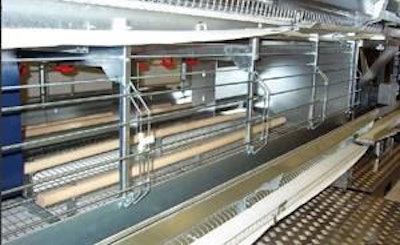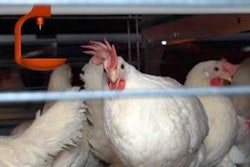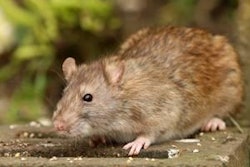
Animal welfare regulations that took effect on January 1, 2012, banned the use of conventional cages for housing laying hens in the EU. The Directive 99/74 established the following requirements for new enclosures or colonies, called "enriched":
- A minimum area of 116 square inches (750 square centimeters) per bird
- The total enclosure will be at least 310 square inches (2,000 square centimeters)
- A nest with a comfortable floor where the birds can lay their eggs
- One area where the chickens can peck and scratch
- Roosts with a minimum length of 5.9 inches (15 centimeters) per bird
- A feeder space of at least 4.7 inches (12 centimeters) per bird
- Availability in each cage of at least two cup or nipple drinkers
- A device to allow all hens to wear down their nails
This legislation sets the requirements for housing to hens in enriched cages, but also outlines the requirements for alternative housing and non-cage systems. Table 1 summarizes the area needed for the four production models that states the EU legislation.
The experience with enriched cages is not expansive. Moreover, even complying with legal requirements, there has been a considerable evolution in the different enriched cage designs so that the production results have varied over the recent years; the same is true for non-cage systems. In both systems, management methods are still being "refined."
The results of different studies show that, in general, the use of enriched cages leads to more dirty and broken eggs than in conventional cages (already banned in the EU), increasing the microbial load on the surface of the shell and therefore the risk of contamination of the eggs contents, especially in weak shells and/or cracked eggs. The larger number of dirty eggs is attributed to eggs laid outside the nest and to difficulties in maintaining hygiene in sizable cages. However, enriched cages show a wide variability of results in this regard. Many factors have found to influence the degree of dirt on eggs and the percentage of broken eggs such as:
- Location of laying within the cage
- Greater or lesser use of nest boxes
- Placing of perches or roosts
- Position of the nest box
- Number of animals in each cage
- Location, material used and access to the scratching area
In systems without cages, percentage of downgraded eggs (broken and dirty) is even more variable than in cages. The key factor is the incidence of floor eggs, which can exceed 10 percent, especially in aviaries, with hens housed in more than one level. There is also a clear relationship between the microbial load per cubic meter of air (related to dust concentration) and contamination of the eggshell.
Some studies observed a somewhat paler shell color in enriched cages compared to conventional cages, attributed to the stress of competition for accessing the nest, causing a greater retention of the egg in the oviduct, with deposition of amorphous calcium carbonate, and finally, bleaching of brown eggs.
No differences were observed in other quality characteristics such as yolk color, albumen height or shell thickness between conventional and enriched cages. In the first, proportion of eggs of more than 63 grams was lower, often observing a reduction of 1-1.5 grams in the mean egg weight, which is attributed to reduced feed intake recorded in these cages.
So far, studies confirm that productivity and mortality are similar in enriched cages compared to conventional cages, but there is a greater risk of casualties from pecking in new cages with large numbers of animals.
Finally, eggs produced both in enriched cages as in systems without cages have a higher production cost compared to conventional cages and those which provide less surface area to birds (Figure 2).
Molting methods in laying hens
After molting, laying hens are productive for another laying cycle, but molting needs to occur simultaneously in all birds of a flock, so therefore, it is necessary to induce this process. Molting aims to regenerate the hen's reproductive tract, so a complete laying interruption is necessary as well as a regression of the reproductive system. This will allow for "rejuvenation" and the start of a new production cycle.
After molting, there is an improvement of the productive results of birds. These improvements are not as quantitative (increased egg weight, fewer broken eggs, higher egg mass) as basically qualitative (albumen quality, thickness and texture of the shell, egg specific weight). The greater egg weight after molting is of great interest in countries where the market has a clear preference for big eggs.
For many years, the most common method used to induce molting was to fast birds for a certain period of time. Despite the unquestioned success of this method, at present, especially in the EU, it is considered that feed deprivation produces a strong stress on the hen, in addition to making it more susceptible to invasion and then colonization of their digestive tract by Salmonella enteritidis. The hormonal changes observed in feed-deprived hens include a long period with higher levels of blood corticosterone, which reduces the immune system’s capacity to fight infections and diseases. Consequently, there are potential negative impacts on animal welfare and food safety. Fasting to induce molting has been banned in the EU.
In recent years, researchers has investigated different methods of molting induction not requiring feed removal, which do not generate stress and, as much as possible, do not decrease the quantitative and qualitative results of subsequent production.
The methods involving supplementation with trace elements like zinc, iodine and aluminum are also very questionable, or even prohibited, because of the risk of accumulation in certain organs, in addition to their practical application in commercial farms is complicated by the difficulty of get a uniform mixture in the ration.
Research has been carried out with high-fiber diets that have lower energy and protein density, through the incorporation of various ingredients and in different proportions, such as alfalfa, grape marc, jojoba meal, cottonseed meal, wheat by-products, tomato pulps, etc.
Whatever the method used to induce molting, the goal is to achieve adequate weight loss and a laying disruption as quickly as possible. Weight loss is the result of the regression of the ovary and oviduct, the mobilization of the lipid reservoir and heat-labile proteins, and loss of digesta. Production recovery after molting is related to the degree of regression and subsequent recovery of above-mentioned organs and tissues. There is a significant positive correlation between the resting period duration (stopping laying) and production per hen housed, after molting. It is believed that complete involution of the oviduct and eggshell gland is needed to achieve a complete rejuvenation of the reproductive tract.
Production results
The overall results of the numerous research works performed to date show quite clearly that alternative methods to induce molting allow for production results which do not differ from those obtained with absolute feed deprivation of hens for several days, and without severe weight losses as those experienced with this method. The challenge is to try to standardize a methodology adapted to each circumstance (breed, season, availability of ingredients to be incorporated in the molting diets, etc.).
Perhaps the success of the traditional system was not only the good results obtained, but also in its ease of application.
In a study conducted by us at the Universidad Politécnica de Madrid, we induced molting to 512 hens with wheat bran, barley and commercial feed provided in restricted amounts (45 g/bird per day), studying laying interruption and the subsequent production recovery (Figure 3).
As can be seen, barley and wheat bran caused laying cessation (<2 percent), relatively quickly, at day seven after initiation of the process, keeping this interruption for 10 days. Commercial feed provided in restricted amounts failed to completely stop laying (4.86 percent) and this minimum level was not achieved until day 14 after the start of treatment with very low persistence, just two days.

















